Important Questions For Class 12 Biology Chapter 2 – Human Reproduction Very Short Question And Answers
Question 1. Breastfeeding the baby acts as a natural contraceptive for the mother because it prevents;
- Ovulation
- Menstruation
- insemination
- Fertilisation
- (2) and (4)
- (1) and (3)
- (1) and (4)
- (1) and (2)
Answer: 2. (1) and (2)
Question 2. The given figure shows the different stages of the human embryo
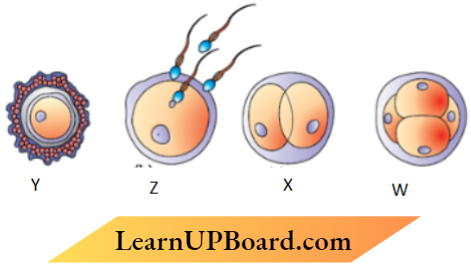
Identify the correct labeling for W, X, and Z, and choose the correct option from the table below.
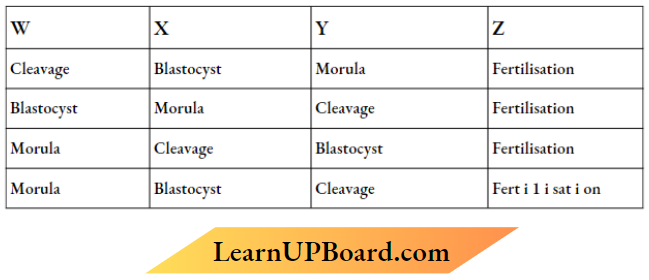
” human reproduction class 12″
Question 3. During human embryonic development, the external genital organs are well-developed in the fetus by the end of
- 6 weeks of pregnancy
- 12 weeks of pregnancy
- 18 weeks of pregnancy
- 24 weeks of pregnancy
Answer: 3. 12 weeks of pregnancy
Read and Learn More Important Questions for Class 12 Biology Chapter Wise
Question 4. The accessory ducts in the human mate reproduct4e system consist of –
- Epididymis, Prostrate. Retetestis
- Rete testis. Vas efferentia. Seminal vesicles
- Vas efferentia. Bulbourethral, epididymis
- Rete testis, epididymis, Vas deferens
Answer: 4. Rete testis, epididymis, Vas deferens
Question 5.Assertion (A): The inner cell mass of the blastocyst gets attached to the endometrium during embryonic development in humans.
Reason (R): The blastomeres in the blastocyst get arranged into trophoblast and inner cell mass.
- Both Assertion (A) and Reason (R) are true and Reason (R) is the correct explanation of Assertion (A).
- Both Assertion (A) and Reason (R) are true, but Reason (R) is not the correct explanation of Assertion (A),
- Assertion ( A) is true, but Reason (R) is false (A) Assertion
- (A) is false, but Reason (R) is true.
Answer: 4. Assertion (A) is false, but Reason (R) is true.
Question 6. Select the correct option for Human Chorionic Gonadotropin (HCG) released during embryonic development in humans.
- Helps in the maintenance of pregnancy.
- leads to rupture of the Graafian follicle.
- Cause strong uterine contraction during childbirth.
- Brings metabolic changes in the mother.
- (1) and (2)
- (1) and (4)
- (2) and (3)
- (2) and (4)
Answer: 2. (1) and (4)
“reproduction chapter class 12 “
Question 7. The source of gonadotropin L.H and its corresponding function is;
- Anterior pituitary, ovulation
- Anterior pituitary Graafian follicle formation
- Hypothaiamus, Ovulation
- Hypothalamus, Graafian follicle formation
Answer: 1. Anterior pituitary, ovulation
Case: A woman of 35 years ago with a married life of eight years and having normal reproductive cycles visits a doctor along with her husband for consultation for infertility. They were not using any contraceptive methods. They have no child. The doctor advises them after a detailed physical examination of both of them to undergo the following investigations
- Seminal analysis of the husband
- Follicular study of the wife.
- Blood test for follicle Stimulating I hormone (FS2) estimation for both
- With your basic knowledge of human embryology and the case g4en above, answer the following questions (8-13) :
Question 8. A seminal analysis of the husband was done to determine
- Sperm morphology
- Quantity and pH of semen
- Rate of sperm release into the Vagina
- (1) only(2)
- (1)and (2)
- (2) and (3)
- (2) only
Answer: 2. (1) and (2)
Question 9. An ultrasound-guided follicular study was done for the wife to determine the size and physical appearance of the
- Ovary
- Oogonia
- Antral follicles
- Corpus Luteum
Answer: 1. Ovary
Question 10. The blood test report of the wife showed a low FSH value, which is indicative of
- low rate of formation of ovarian follicles
- high rate of formation of ovarian follicles
- low rate maturation of ovarian follicles
- high rate of maturation of ovarian follicles
Answer: 1. low rate of formation of ovarian follicles
human reproduction class 12 textbook
Question 11. In the above case if the husband is found to have a sperm count of less than 20 million or mL and the wife is diagnosed with blockage in the oviduct, the couple would be advised to:
- ZlFT
- Al
- IVF
- 1CSI
- (1) and (3)
- (2) and (3)
- (3) and (4)
- (1) and (4)
Answer: 1. (1) and (3)
Question 12. The high level of gonadotropin or ovarian hormone in the blood sample of the wife taken on day 20 of her reproductive (menstrual) cycle would indicate the actual phase of the ovarian cycle
- FSH
- LH
- Estrogens
- Progesterone
Answer: 4. Progesterone
Question 13. In which phase of the menstrual cycle is the blood sample of women taken if, on analysis, it shows high levels of 1 I I and estrogen?
- Ovulatory phase
- Menstrual phase
- Secretory phase
- Follicular phase
Answer: 1. Ovulatory phase
Question 14.
1. The specific site for fertilization in human females is
- Infundibulum
- Uterus
- Ampulla
- Ampullary isthmic junction
Answer: 3. Ampulla
2. The hormone that regulates the synthesis and secretion of androgens in human males is
- GH
- FSH
- LH
- Prolactin
Answer: 3. LH
Important Questions for Class 12 Biology Chapter 2 – Human Reproduction Short Answer Questions
Question 1. Name and state the function of interstitial cells present in the human testes.
Answer:
Interstitial cells or Ley dig cells Leydtg cells synthesize and secrete testicular hormones called androgens.
Question 2. List the three hormones produced in women only during pregnancy. What happens to the levels of estrogen and progesterone during pregnancy?
Answer:
- Human chorionic gonadotropin or hCG.
- Human placental lactogen or HPI
- Relaxin, (The level of progesterone And estrogen) increases
Question 3. Explain the uterine changes during the menstrual cycle’s follicular phase in a human female. Name and explain the role of hormones that bring about these changes.
Answer:
The menstrual phase is followed by the follicular phase During this phase, the primary follicles in the ovary grow to become a fully mature Graafian follicle and simultaneously the endometrium of the uterus regenerates through proliferation These changes in the ovary and the uterus are induced by changes in the levels of pituitary and ovarian hormones. The secretion of gonadotropins (111 and FSH) increases gradually during the follicular phase and stimulates follicular development and secretion of estrogens by the growing follicles.
human reproduction project pdf class 12
Question 4. Name the three different parts of human sperm and write their involvement in the process of fertilization.
Answer:
- Aerosome – filled with an enzyme that helps the sperm to enter into the ovum through zona pellucida
- Nucleus – containing chromosomal material or genetic material
- Mitochondria Or Middle piece – energy source for swimming
- Tail – it helps in movement or motility
Question 5. Construct a flow chart exhibiting sequential events of oogenesis.
Answer:
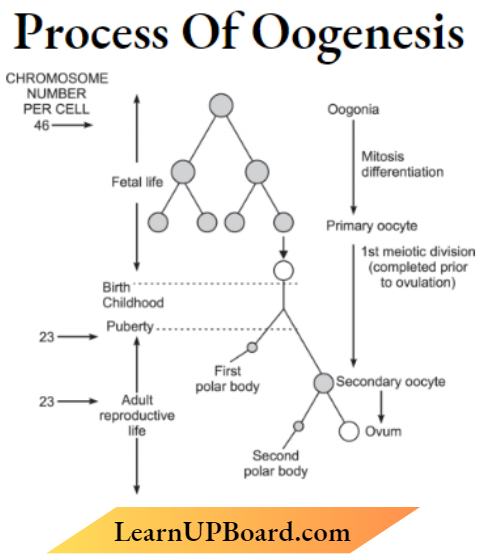
Question 6. Draw a diagrammatic sectional view of a seminiferous tubule (enlarged) in humans and label its parts.
Answer:
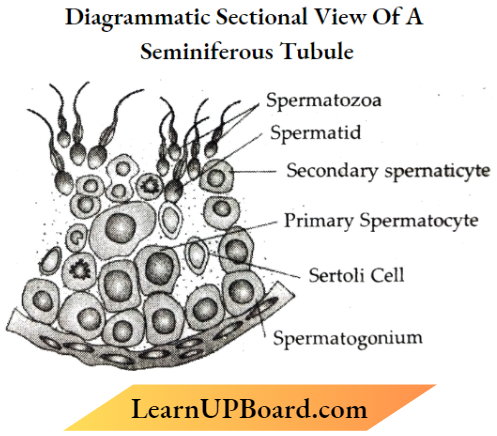
biology chapter 3
Question 7. Draw a diagram of a mature human sperm, label any three parts, and write their functions.
Answer:
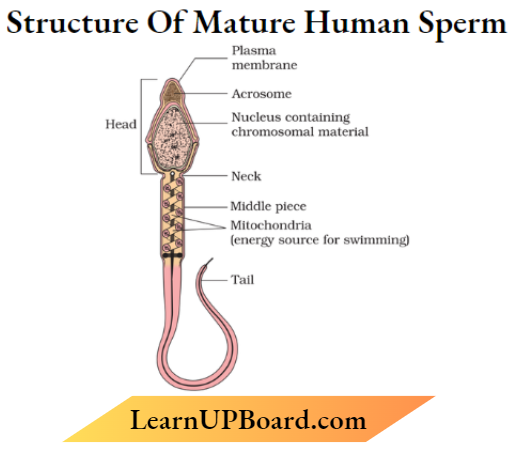
- Plasma membrane – Envelope of the sperm
- Acrosome – Filled with an enzyme that helps fertilization of the ovum
- Mitochondria – Energy source for swimming
- Middle Piece – Possess mitochondria which is the energy
- Tail – For movement of sperm
- Nucleus – Containing chromosomal material
Question 8. Medically it is advised to all young mothers that breastfeeding is the best for their newborn babies. Do you agree? Give reasons in support of your answer.
Answer:
Yes. it provides nutrition like calcium. fats, lactose, or provides passive immunity or antibodies like IgA
Question 9:
1. Draw a diagram of a sectional view of the human ovary and label
- Primary follicle
- Tertiary follicle
- Graafian follicle and
- Corpus luteum.
Answer: 1. Primary follicle

2. Write the function of the corpus luteum.
Answer:
- The corpus luteum secretes large amounts of progesterone which is essential for maintenance of the endometrium.
- Such an endometrium is necessary for the implantation of the fertilized ovum and other events of pregnancy.
- During pregnancy, all events of the menstrual cycle stop and there is no menstruation, in the absence of fertilization, the corpus luteum degenerates.
- This causes disintegration of the endometrium leading to menstruation, marking a new cycle.
Important Questions for Class 12 Biology Chapter 2 – Human Reproduction Long Question And Answers
Question 1. Study the figure given below of a human female reproductive tract showing the transport of the ovum, its fertilization, and the growing embryo moving through the fallopian tube and answer the questions that follow :
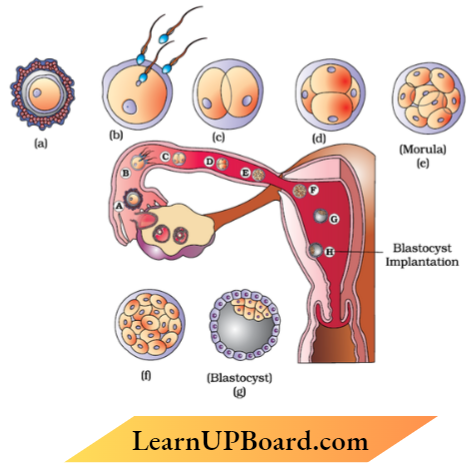
1. Identify the embryonic stages ‘e’ and ‘g’ and differentiate between them.
Answer:
e – Morula – The embryo with 8 to 16 blastomeres is called a morula.
g = Blastocyst – The morula continues to divide and transforms into blastocyst it has 32 cells.
2. Describe the process of implantation as shown in Figure H’
H- Implantation – The trophoblast layer then gets attached to the endometrium and the inner cell mass gets differentiated as the embryo. After attachment, the uterine cells divide rapidly and cover the blastocyst. As a result, the blastocyst becomes embedded in the endometrium of the uterus. This is called implantation and it leads to pregnancy.
Question 2:
1. Draw a sectional view of a human ovary and label the primary follicle, tertiary follicle, Graafian follicle, and corpus luteum in it.
Answer:

2. Name the gonadotropins and explain their role in oogenesis and the release of ova.
LH, FSH
Both Lit and F8H increase during the follicular phase and stimulate follicular development, as well as the secretion of estrogen by the growing follicles. LIT surge ( rapid secretion of LH) during mid-cycle or 14 days or induces rupture of Grafftan follicle and release of the ovary or secondary oocyte.
Question 3:
1. Describe the different stages of development a fertilized ovum in a human female undergoes up to the blastocyst stage.
Answer:
The zygote moves through the isthmus of the oviduct towards the uterus, and the mitotic division called cleavage begins, forming 2, 4, 8, and 16 daughter cells, called blastomeres, the embryo with 8 to 16 blastomeres is called a morula, the morula continues to divide and transforms into blastocyst.
2. Name the parts of a blastocyst and write the fate of these parts till the onset of pregnancy.
Answer:
- Trophoblast: Gets attached to the endometrium for implantation/helps in the formation of the placenta.
- Inner cell mass: The inner cell mass gets differentiated as the embryo.
Question 4.
1. Explain the events that occur in the uterus during the menstrual cycle in human females.
Answer:
- Menstrual Phase, the the endometrial lining of the uterus and the blood vessels are, in the Proliferative phase endometrium regenerates due to proliferation (this phase is under the influence of estrogen).
- The secretory phase is for the maintenance of the endometrium of the uterus to receive the embryo (this phase is under the influence of Progesterone).
2. What is parturition? Mention how it is induced.
Answer:
The process of delivery of the fetus (childbirth), is induced by a complex neuroendocrine mechanism.
Question 5.
1. Explain the menstrual cycle in human females.
Answer:
- Menstrual Phase – Menstrual flow occurs due to the breakdown of the endometrial lining of the uterus, when fertilization does not occur.
- Follicular Phase – Primary follicles grow into mature Graafian follicles and endometrium regenerates through proliferation, changes induced by pituitary and ovarian hormones.
- Ovulatory Phase – LH surge, induces rupture of Graafian follicle and release of secondary oocyte or ovum during the middle of the cycle (therefore 14th day).
- Luteal phase – Ruptured Graafian follicle transforms into corpus luteum which secrete a large amount of progesterone, essential for maintaining endometrium.
2. How can the scientific understanding of the menstrual cycle of human females help as a contraceptive measure?
Answer:
Because ovulation occurs during the mid-mid-cycle, chances of fertilization are very high so, couples should abstain from coitus between the 10th and 17th day.
Question 6.
1. Draw a diagram of the adult human female reproductive system and label the different :
- parts of the fallopian tube
- Layers of the uterus wall
Answer:
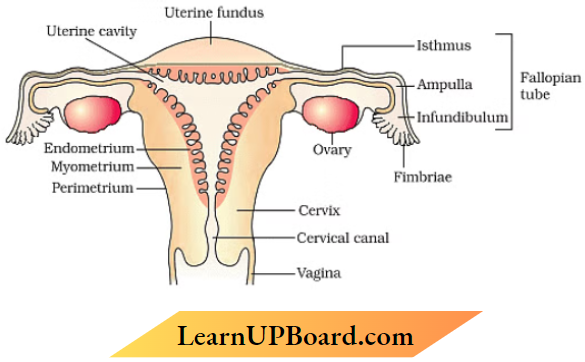
2. Explain the events during fertilization of an ovum in humans.
When a sperm comes in contact with Zona pellucida of the ovum this induces changes in the membrane that blocks entry of additional sperm. secretions of acrosome help sperm enter into the cytoplasm of the ovum through zona pellucida and plasma membrane, this I the completion of the meiotic division of secondary oocyte and formation of a haploid ootid/ovum (and a second polar body), haploid nucleus of ovum fuses with sperm nucleus to form a diploid zygote (fertilization occurs)
Question 7:
1. Explain the following phases in the menstrual cycle of a human female:
- Menstrual phase
- Follicular phase
- Luteal phase
Menstrual phase – First 3-5 days of the cycle where menstrual flow occurs due to the breakdown of the endometrial lining of the uterus, if the released ovum is not fertilized.
The follicular phase – From the 5th to the 14th day of the cycle where the primary follicles grow to become a fully mature Graafian follicle, and the endometrium of the uterus regenerates. Graafian follicle ruptures to release ova (ovulation on 14 th day)
Futeal Phase – During the 15thto 28th day remaining parts of the Graafian follicle transform into corpus luteum, and secretion of progesterone (essential for the maintenance of endometrium) All these phases are under the influence of varying concentrations of pituitary and ovarian hormone
2. A proper understanding of the menstrual cycle can help immensely in family planning. Do you agree with the statement? Provide reasons for your answer.
Answer:
Yes, can take appropriate precautions between the 10th and 7th day of t(a) Menstrual phase – first 3-5 days of the cycle where menstrual flow occurs due to break down of the endometrial lining of the uterus if the released ovum is not fertilized.
